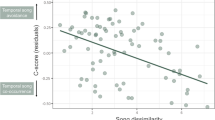Abstract
Understanding mechanisms that promote colonization by target species is critical to advancing the success of coastal wetland restoration. Recent work in avian behavioral ecology suggests that social cues might influence settlement decisions in a range of species, however little is known about the extent to which social mechanisms might influence settlement decisions for those inhabiting coastal wetlands. In this study, we tested whether or not the saltmarsh sparrow (Ammodramus caudacutus), an obligate saltmarsh species of conservation concern, uses conspecific attraction to make habitat selection decisions. Despite previous research suggesting a potential role for auditory conspecific cues in sparrow settlement decisions, we found no evidence that saltmarsh sparrows respond to them in two distinct experiments. Playing saltmarsh sparrow vocalizations at 11 sites with very low saltmarsh sparrow densities did not change numbers from those observed in prior years. In a controlled experiment at marshes with high saltmarsh sparrow densities, numbers of adults, nests, and fledglings were similar at control and experimental plots. The results of this study suggest that auditory conspecific cues are not an important component of habitat settlement decisions for this species and are unlikely to facilitate the colonization of unoccupied habitat.

Similar content being viewed by others
References
Ahlering MA, Faarborg J (2006) Avian habitat management meets conspecific attraction: if you build it, will they come? Auk 123:301–312
Ahlering MA, Johnson DH, Faaborg F (2006) Conspecific attraction in a grassland bird, the Baird’s Sparrow. Journal of Field Ornithology 77:365–371
Alatalo RV (1982) Can the song of male birds attract other males? An experiment with the pied flycatcher Ficedula hypoleuca. Bird Behavior 4:42–45
American Bird Conservancy (2007) American Bird Conservancy Red List. Available at http://www.abcbirds.org/abcprograms/science/watchlist/watchlist.html. Accessed 17 September 2009.
Athearn ND, Takekawa JY, Shinn JM (2009) Response to early tidal salt marsh restoration at former commercial salt evaporation ponds in San Francisco Bay, California, USA. Natural Resources and Environmental Issues 15:77–86
Bayard TS (2010) Testing the role of social cues in saltmarsh sparrow habitat selection decisions. Ph.D. dissertation, University of Connecticut, Storrs
Bayard TS, Elphick CS (2010) Using spatial point pattern assessment to understand the social and environmental mechanisms driving avian habitat selection. Auk 127:485–494
Bayard TS, Elphick CS (2011) Planning for sea level rise: quantifying patterns of saltmarsh sparrow nest flooding under current sea level conditions. Auk 128:393–403
Benoit LK, Askins RA (2002) Relationship between habitat area and the distribution of tidal marsh birds. Wilson Bulletin 114:314–323
Betts MG, Hadley AS, Rodenhouse N, Nocera JJ (2008) Social information trumps vegetation structure in breeding site selection by a migrant songbird. Proceedings of the Royal Society of London - Series B: Biological Sciences 275:2257–2263
BirdLife International (2009) IUCN Red List for birds. Downloaded from http://www.birdlife.org. Accessed 01 June 2009
Boulinier T, Danchin E, Monnat J-Y, Doutrelant C, Cadiouu B (1996) Timing of prospecting and the value of information in a colonial breeding bird. Journal of Avian Biology 27:252–256
Brewer R, Harrison KG (1975) The time of habitat selection in birds. Ibis 117:521–522
Campomizzi AJ, Butcher JA, Farrell SL, Snelgrove AG, Collier BA, Gutzwiller KJ, Morrison ML, Wilkins RN (2008) Conspecific attraction is a missing component in wildlife habitat modeling. Journal of Wildlife Management 72:331–336
Dettmers R, Rosenberg KV (2000) Partners in Flight bird conservation plan for southern New England (physiographic area 9). Version 1.0. American Bird Conservancy
Elphick CS, Bayard T, Meiman S, Hill JM, Rubega MA (2009) A comprehensive assessment of the distribution of saltmarsh sharp-tailed sparrows in Connecticut. Final report to the Long Island Sound License Plate Program, Connecticut Department of Environmental Protection. University of Connecticut, Storrs.
EPA (2000) Principles for the ecological restoration of aquatic resources. EPA841-F-00-003. Office of Water (4501F), United States Environmental Protection Agency, Washington DC.
Fletcher RJ (2007) Species interactions and population density mediate the use of social cues for habitat selection. Journal of Animal Ecology 76:598–606
Forbush EH (1929) Land birds from sparrows to thrushes. In: Birds of Massachusetts and other New England states, Part 3. Massachusetts Department of Agriculture Norwood Press, MA, pp 61–64.
Gilroy JJ, Sutherland WJ (2007) Beyond ecological traps: perceptual errors and undervalued resources. Trends in Ecology & Evolution 22:351–356
Gjerdrum C, Elphick CS, Rubega M (2005) Nest site selection and nesting success in saltmarsh breeding sparrows: the importance of nest habitat, timing, and study site differences. Condor 107:849–862
Gjerdrum C, Elphick CS, Rubega MA (2008) How well can we model numbers and productivity of Saltmarsh Sharp-tailed Sparrows (Ammodramus caudacutus) using habitat features. Auk 125:608–617
Greenlaw JS, Rising JD (1994) Sharp-tailed sparrow (Ammodramus caudacutus). In: Poole A, Gill F (eds) The birds of North America, No. 112. Philadelphia (PA): Academy of Natural Sciences, Washington D.C.: American Ornithologists’ Union.
Hahn BA, Silverman ED (2006) Social cues facilitate habitat selection: American redstarts establish breeding territories in response to song. Biology Letters 2:337–340
Hahn BA, Silverman ED (2007) Managing breeding forest songbirds with conspecific song playbacks. Animal Conservation 10:436–441
Harrison ML, Green DJ, Krannitz PG (2009) Conspecifics influence the settlement decisions of male Brewer’s Sparrows at the northern edge of their range. Condor 111:722–729
Hill CE, Gjerdrum C, Elphick C (2010) Extreme levels of multiple mating characterize the mating system of the Saltmarsh Sparrow (Ammodramus caudacutus). Auk 127:300–307
Hunter ML (2007) Climate change and moving species: furthering the debate on assisted colonization. Conservation Biology 21:1356–1358
Konisky RA, Burdick DM, Dionne M, Neckles HA (2006) A regional assessment of salt marsh restoration and monitoring in the Gulf of Maine. Restoration Ecology 14:516–525
Kress SW (1983) The use of decoys, sound recording, and gull control for reestablishing a tern colony in Maine. Colonial Waterbirds 6:185–196
McLachlan JS, Hellman JJ, Schwartz MW (2007) A framework for debate of assisted migration in an era of climate change. Conservation Biology 21:297–302
Meiman S (2011) Modeling saltmarsh sparrow distribution in Connecticut. Master’s thesis, University of Connecticut, Storrs
Mills AM, Rising JD, Jackson DA (2006) Conspecific attraction during establishment of Least Flycatcher clusters. Journal of Field Ornithology 77:34–38
Murray BG Jr (1969) A comparative study of the Le Conte’s and Sharp-tailed Sparrows. Auk 86:199–231
Nocera JJ, Forbes GJ, Giraldeau LA (2006) Inadvertent social information in breeding site selection of natal dispersing birds. Proceedings of the Royal Society of London - Series B: Biological Sciences 273:349–355
Parker MW, Kress SW, Golightly RT, Carter HR, Parsons EB, Schubel SE, Boyce JA, McChesney GJ, Wisely SM (2007) Assessment of social attraction techniques used to restore a Common Murre colony in central California. Waterbirds 30:17–28
Reed JM (2004) Recognition behavior based problems in species conservation. Annales Zoologici Fennici 41:859–877
Reinert SE, Mello MJ (1995) Avian community structure and habitat use in a southern New England estuary. Wetlands 15:9–19
Rich TD, Beardmore CJ, Berlanga H, Blancher PJ, Bradstreet MSW, Butcher GS, Demarest DW, Dunn EH, Hunter WC, Iñigo-Elias EE, Kennedy JA, Martell AM, Panjabi AO, Pashley DN, Rosenberg KV, Rustay CM, Wendt JS, Will, TC (2004) Partners in flight North American landbird conservation plan. Cornell Lab of Ornithology, Ithaca, NY. Available at www.partnersinflight.org/cont_plan/
Seigel A, Hatfield C, Hartman JM (2005) Avian response to restoration of urban tidal marshes in the Hackensack Meadowlands, New Jersey. Urban Habitats 3:87–116
Shriver WG, Hodgman TP, Gibbs JP, Vickery PD (2004) Landscape context influences salt marsh bird diversity and area requirements in New England. Biological Conservation 119:545–553
Shriver WG, Vickery PD, Hodgman TP (2007) Flood tides affect breeding ecology of two sympatric sharp-tailed sparrows. Auk 124:552–560
Stamps JA, Krishnan VV, Reid ML (2005) Search costs and habitat selection by dispersers. Ecology 86:510–518
Stralberg D, Brennan M, Callaway JC, Wood JK, Schile LM et al (2011) Evaluating tidal marsh sustainability in the face of sea-level rise: a hybrid modeling approach applied to San Francisco Bay. PLoS One 6(11):e27388
Wagner RH, Danchin E (2003) Conspecific copying: a general mechanism of social aggregation. Animal Behavior 65:405–408
Ward MP, Schlossberg S (2004) Conspecific attraction and the conservation of territorial songbirds. Conservation Biology 18:519–525
Ward MP, Benson TJ, Semel B, Herkert JR (2010) The use of social cues in habitat selection by wetland birds. Condor 112:245–251
Warren RS, Fell PE, Rozsa R, Brawley AH, Orsted AC, Olson ET, Swamy V, Niering WA (2002) Salt marsh restoration in Connecticut: 20 years of science and management. Restoration Ecology 10:497–513
Acknowledgements
We thank the Connecticut Department of Environmental Protection, Madison Land Trust, and Guilford Land Conservation Trust for allowing us access to their properties; C. Lewis and T. Steeves for assisting with field work; J. Fieth, C. Field, and the Borror Lab of Bioacoustics at Ohio State University for use of sparrow recordings; C. Field and A. Borowske for access to unpublished information; and S. Meiman for making Fig. 1. E.S. Adams, R. Chazdon, J.M. Reed, K. Wells, the associate editor, and two anonymous reviewers provided comments that greatly improved the final draft. Graham Morfitt at Modern Outpost provided invaluable assistance in developing the solar broadcast prototype. T.S.B. was supported by funds from the University of Connecticut, including the Manter Fund, George Clark Jr. Endowment and Center for Conservation and Biodiversity, as well as funds from the American Museum of Natural History Frank M. Chapman Award, the Animal Behavior Society Student Research Award, the Cooper Ornithological Society Mewaldt-King Award, the Garden Club of America Francis M. Peacock Award, the Quebec-Labrador Foundation Sounds Conservancy Grant, and the Wilson Ornithological Society’s Paul A. Stewart Award.
Author information
Authors and Affiliations
Corresponding author
Rights and permissions
About this article
Cite this article
Bayard, T.S., Elphick, C.S. Testing for conspecific attraction in an obligate saltmarsh bird: Can behavior be used to aid marsh restoration?. Wetlands 32, 521–529 (2012). https://doi.org/10.1007/s13157-012-0287-7
Received:
Accepted:
Published:
Issue Date:
DOI: https://doi.org/10.1007/s13157-012-0287-7




